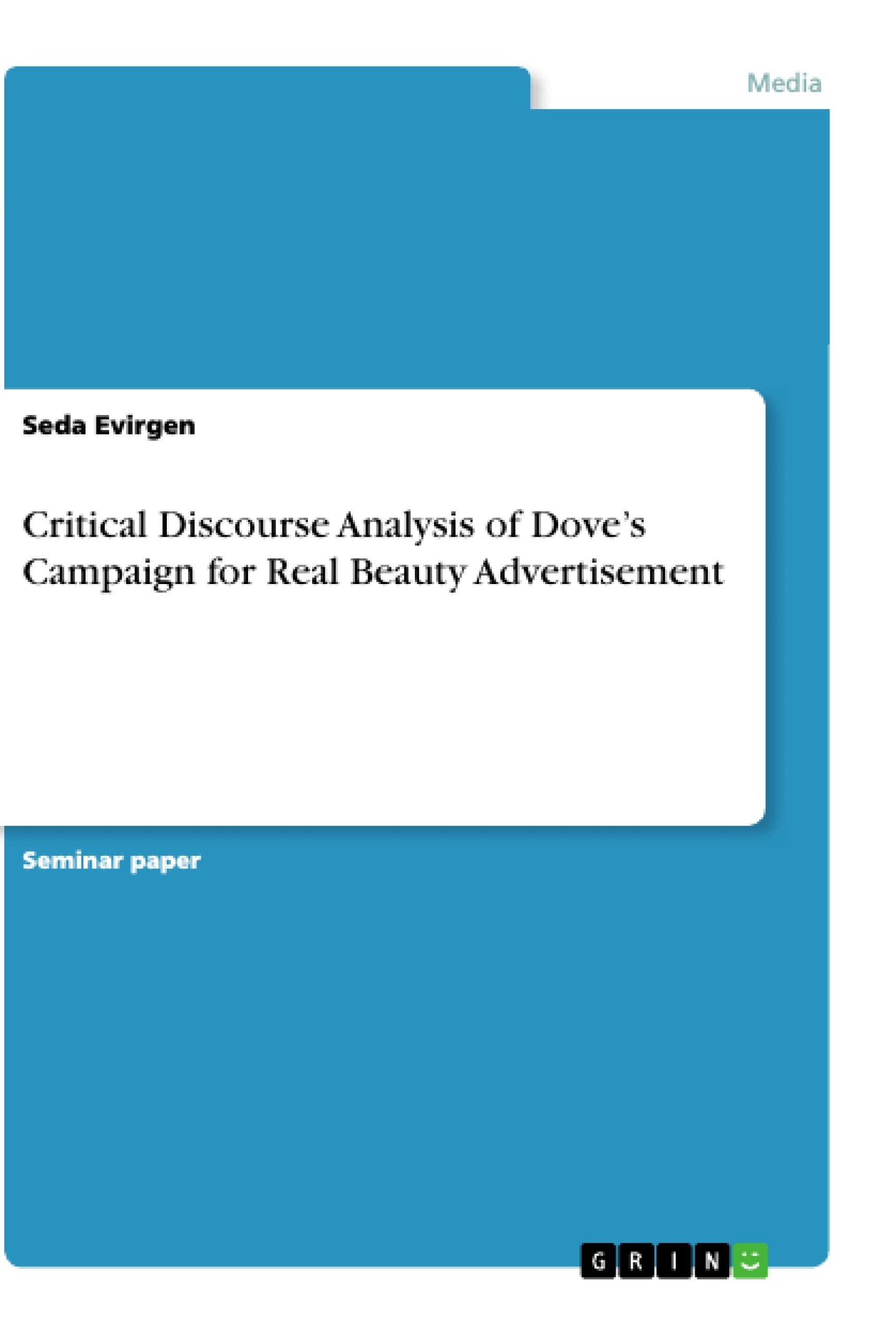The purpose of this paper is to explore how Dove experienced the corporate social responsibility paradox, which occurs when a CSR campaign hurts the brand’s reputation instead of benefiting it. Dove communicates its corporate social responsibility activities, as part of its marketing strategy, through social media, which caused in some cases criticism and backlash towards the brand. Even though the message from Dove, that everyone is beautiful in their own way, was perceived positively, the way it was being advertised and represented also caused negative consumer responses toward Dove. The advertisement that was criticized and is the object of investigation in this paper, is the body-shaped bottle advertisement, that was published as part of Dove’s Real Beauty Campaign. The analysis of the advertisement will be conducted according to Fairclough’s (1989, 1995) model for critical discourse analysis. The aim of the Critical Discourse Analysis (CDA) is to explore the visuals, ideology and stereotypes behind the advertisement, what the reason for the negative responses could be, the role of social media in this context and the resulting consequences for Dove.
Table of Contents
- 1 Introduction
- 2 Theory
- 2.1 Corporate Social Responsibility and Communication
- 2.2 Dove's Campaign for Real Beauty
- 3 Methods and Data
- 4 Analysis
- 4.1 "Beauty comes in all shapes and sizes"
- 4.2 Consequences for Dove
- 5 Conclusion
Objectives and Key Themes
This paper aims to analyze Dove's "Campaign for Real Beauty" advertisement, specifically the body-shaped bottle advertisement, and its reception on social media. It examines the paradoxical effect of a CSR campaign that, despite intending to promote body positivity, triggered negative responses. The analysis utilizes Fairclough's model of Critical Discourse Analysis to explore the advertisement's visuals, ideology, and the role of social media in shaping public opinion.
- Corporate Social Responsibility (CSR) and its communication strategies
- The paradox of CSR campaigns negatively impacting brand reputation
- Critical Discourse Analysis of Dove's advertisement
- The influence of social media on brand perception and consumer responses
- The interplay between marketing, CSR, and public opinion
Chapter Summaries
1 Introduction: This introductory chapter sets the stage by discussing the growing importance of corporate social responsibility (CSR) in marketing strategies. It highlights the evolving landscape of communication, particularly the crucial role of social media in shaping brand perception and consumer behavior. The chapter introduces Dove as a case study, focusing on its significant online presence and its "Real Beauty" campaign. The central question is how a CSR campaign, intending to foster positive brand image, can inadvertently lead to negative consequences due to online reactions. The body-shaped bottle advertisement is introduced as the central focus of the analysis, using Fairclough's model for critical discourse analysis.
2 Theory: This chapter lays the theoretical groundwork for the subsequent analysis. It begins by defining corporate social responsibility (CSR) within the context of communication and social media. The chapter establishes a connection between CSR activities and their online dissemination, emphasizing the potential for both positive and negative repercussions through social media platforms. The concept of the "corporate social responsibility paradox" is introduced – the possibility that a well-intentioned CSR initiative can backfire and harm a company's reputation. The chapter prepares the reader for the application of Fairclough's critical discourse analysis framework to the Dove advertisement.
Keywords
Corporate Social Responsibility (CSR), marketing communication, social media, Dove, Real Beauty Campaign, critical discourse analysis, brand reputation, body image, consumer response, online advertising, social media marketing, viral marketing.
Dove's "Campaign for Real Beauty": A Critical Discourse Analysis - FAQ
What is the main topic of this paper?
This paper analyzes Dove's "Campaign for Real Beauty," specifically focusing on a body-shaped bottle advertisement and its reception on social media. It examines how a CSR campaign aiming for body positivity inadvertently triggered negative responses, highlighting the paradox of CSR initiatives.
What methodology is used in this analysis?
The analysis employs Fairclough's model of Critical Discourse Analysis to examine the advertisement's visuals, ideology, and the influence of social media on public opinion. This framework allows for a deeper understanding of the interplay between the advertisement's message, its interpretation, and the resulting online reactions.
What are the key themes explored in the paper?
Key themes include Corporate Social Responsibility (CSR) and its communication strategies; the paradox of CSR campaigns negatively impacting brand reputation; Critical Discourse Analysis of Dove's advertisement; the influence of social media on brand perception and consumer responses; and the interplay between marketing, CSR, and public opinion.
What are the chapter summaries?
The Introduction sets the context, introducing Dove's "Real Beauty" campaign and its online presence, posing the central question of how a CSR campaign can lead to negative consequences. The Theory chapter defines CSR in the context of communication and social media, introducing the "corporate social responsibility paradox" and Fairclough's critical discourse analysis. The paper also includes chapters on Methods and Data and Analysis, focusing specifically on the "Beauty comes in all shapes and sizes" tagline and its consequences for Dove, culminating in a Conclusion.
What are the key objectives of the study?
The primary objective is to analyze Dove's body-shaped bottle advertisement and its social media reception. It aims to understand the paradoxical effect of a CSR campaign that, despite positive intentions, generated negative responses. The study also seeks to explore the role of social media in shaping public opinion regarding such campaigns.
What keywords are associated with this research?
Keywords include Corporate Social Responsibility (CSR), marketing communication, social media, Dove, Real Beauty Campaign, critical discourse analysis, brand reputation, body image, consumer response, online advertising, social media marketing, and viral marketing.
What is the structure of the provided preview?
The preview offers a comprehensive overview, including the title, table of contents, objectives and key themes, chapter summaries, and keywords. This allows for a thorough understanding of the research's scope and findings before accessing the full text.
- Quote paper
- Seda Evirgen (Author), 2019, Critical Discourse Analysis of Dove’s Campaign for Real Beauty Advertisement, Munich, GRIN Verlag, https://www.grin.com/document/964875




